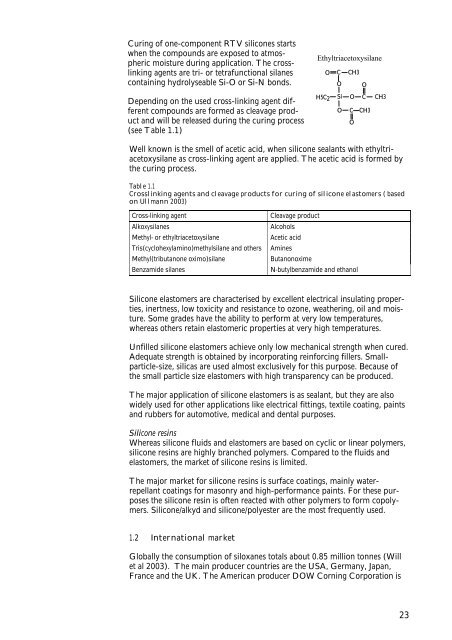No. 1031 - Miljøstyrelsen
No. 1031 - Miljøstyrelsen
No. 1031 - Miljøstyrelsen
You also want an ePaper? Increase the reach of your titles
YUMPU automatically turns print PDFs into web optimized ePapers that Google loves.
Curing of one-component RTV silicones starts<br />
when the compounds are exposed to atmospheric<br />
moisture during application. The crosslinking<br />
agents are tri- or tetrafunctional silanes<br />
containing hydrolyseable Si-O or Si-N bonds.<br />
Depending on the used cross-linking agent different<br />
compounds are formed as cleavage product<br />
and will be released during the curing process<br />
(see Table 1.1)<br />
Well known is the smell of acetic acid, when silicone sealants with ethyltriacetoxysilane<br />
as cross-linking agent are applied. The acetic acid is formed by<br />
the curing process.<br />
Table 1.1<br />
Crosslinking agents and cleavage products for curing of silicone elastomers ( based<br />
on Ullmann 2003)<br />
Cross-linking agent Cleavage product<br />
Alkoxysilanes Alcohols<br />
Methyl- or ethyltriacetoxysilane Acetic acid<br />
Tris(cyclohexylamino)methylsilane and others Amines<br />
Methyl(tributanone oximo)silane Butanonoxime<br />
Benzamide silanes N-butylbenzamide and ethanol<br />
Silicone elastomers are characterised by excellent electrical insulating properties,<br />
inertness, low toxicity and resistance to ozone, weathering, oil and moisture.<br />
Some grades have the ability to perform at very low temperatures,<br />
whereas others retain elastomeric properties at very high temperatures.<br />
Unfilled silicone elastomers achieve only low mechanical strength when cured.<br />
Adequate strength is obtained by incorporating reinforcing fillers. Smallparticle-size,<br />
silicas are used almost exclusively for this purpose. Because of<br />
the small particle size elastomers with high transparency can be produced.<br />
The major application of silicone elastomers is as sealant, but they are also<br />
widely used for other applications like electrical fittings, textile coating, paints<br />
and rubbers for automotive, medical and dental purposes.<br />
Silicone resins<br />
Whereas silicone fluids and elastomers are based on cyclic or linear polymers,<br />
silicone resins are highly branched polymers. Compared to the fluids and<br />
elastomers, the market of silicone resins is limited.<br />
The major market for silicone resins is surface coatings, mainly waterrepellant<br />
coatings for masonry and high-performance paints. For these purposes<br />
the silicone resin is often reacted with other polymers to form copolymers.<br />
Silicone/alkyd and silicone/polyester are the most frequently used.<br />
1.2 International market<br />
Ethyltriacetoxysilane<br />
C CH3<br />
Globally the consumption of siloxanes totals about 0.85 million tonnes (Will<br />
et al 2003). The main producer countries are the USA, Germany, Japan,<br />
France and the UK. The American producer DOW Corning Corporation is<br />
O<br />
H5C2<br />
O<br />
Si<br />
O<br />
O C CH3<br />
O C CH3<br />
O<br />
23

















